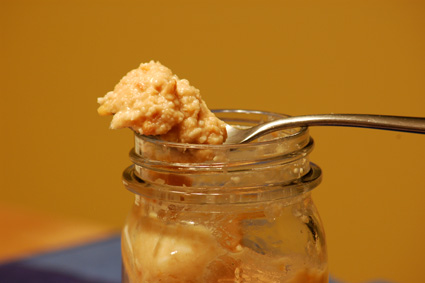Miso might very well be the most unusual thing I have ever made, which is no small feat when the other contenders include kimchi and sauerkraut, olives, and, of course, head cheese. Fortunately, I'm thrilled with the results, both because it tastes great and doesn't appear to be poisoning me.1

Making miso - and shoyu, which I'll be starting up soon - is a multi-stage process.2 Also of concern3 for the novice miso-maker: unless you're Japanese, odds are you're no connoisseur of miso, and thus the line separating good from bad is rather fuzzy; the entire process takes weeks, months, or even a year before you have a final product; (warm) temperature control is especially important; and the fermentation relies on a whole host of different types of microorganisms - molds, yeasts, bacteria - so it's not as predictable as, say, brewing beer. Plus, you need to have some miso before you can make miso.
I think of it as a helical process. It circles about to where it began, but it's also taken a step forward. Like a sourdough starter, each new batch contains some (ever smaller) fraction of the original.
Let's say you want to make miso at home. Here's a brief rundown on the process.
Miso starts with a mold and rice culture called koji. Steam white short-grain rice until it's thoroughly cooked. Inoculate with Aspergillus oryzae - which you can order in packets of dry spores - a mold that breaks down the starches and other compounds in rice and soybeans. Keep it warm - 85°F - for 48 hours.4
If all goes well, you've got koji, which looks like rice dusted in flour. It smells good, mushroomy and yeasty, and just a bit sweet. The individual grains or rice are intact, but are brittle, and you can see the white mold all the way through to the center.
The next step varies slightly, depending on what sort of miso you're making. White shiro miso ferments quickly - a few weeks, rather than months - and was the first batch by default. It calls for cooked soybeans, salt, and a bit of seed miso. The soybean cooking is another time sink, because it takes in the neghborhood of four hours5 to boil soybeans until soft.
With prepared koji and cooked soybeans, it's a simple matter of mixing the two with a little of the soybean cooking water, some salt, and your seed miso. That last ingredient is super-important, because that little tablespoon of unpasteurized miso contains the wide array of microorganisms that will help turn your moldy rice and beans into richly flavored miso. As the whole mixture ages, the aroma changes and intensifies, until finally it's ready to be used. In theory, it should remain at 77°F during that time, but that's not a target temperature I can provide at home; mine fermented longer, at a lower temperature, which I've no doubt influenced the distinct aroma it has. It may be shiro miso, but it smells and tastes distinctly different from the shiro miso I'd used to seed it in the first place.
Most misos are salty, and between that and the long fermentation, they're relatively safe stored unrefrigerated, or so I hear, but they'll last indefinitely if kept cool. Shiro miso, though, won't last outside the fridge, so I now have about a quart and a half - minus what we've eaten so far - ready for enjoyment anytime.
I'm still looking for ideas on how best to use it. Miso soup is good, of course, and I rather enjoy having it for breakfast from time to time. (I just make a mug of it.) Mixing it in with ground peanuts, sesame seeds, and soy sauce makes a delicious dressing for vegetables like broccoli or green beans. Dark misos are excellent with meats - especially as a pre-grilling rub - but I don't see the shiro miso taking on that role. I'm thinking about using it as a filling for some northern Chinese-style steamed buns, just to see how it goes.
* * * * *
1Always a bonus.
2Red flag.
3More red flags.
4Unless you happen to have an incubator handy - which I don't - it's a job that calls for some serious attention. A cooler, some towels, and a large pot of warm water - regularly replaced and adjusted - did the trick, but it was immensely distracting.
5Or half an hour if you've got a pressure cooker. Which I don't.

2 comments:
Madhur Jaffrey recommends using lighter misos as a coating for pan-fried or grilled vegetables, specifically eggplant. I don't know if your miso will last long enough for eggplants to be in season, but you could experiment with other veggies.
Oh, eggplant. Still so far away... The seeds don't escape their packets for another week or so.
That's a thought, at least. No reason that grilling season shouldn't kick off well before the eggplant arrive.
Post a Comment